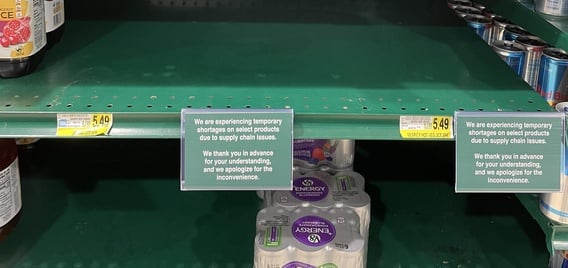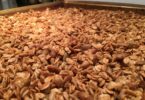Editor’s note: This story is part of a series on the trends that will shape the food and beverage industry in 2022.
As Hain Celestial prepared to consolidate two U.S. snack plants into one this past spring, CEO Mark Schiller faced a big problem that threatened to halt production of one of its biggest food brands: a labor shortage, which made it impossible to hire the 200 workers needed to staff the new facility.
The former Pinnacle Foods and PepsiCo executive quickly responded by hiring a manufacturer overseas before the product was air freighted to the United States “at a huge cost just to be able to keep it in stock so the retailers didn’t replace me with something else,” Schiller said.
Today, that partner has not only become a permanent supplier but also the first in a broader push by Hain to diversify the number of companies who make its products and packaging, supply its ingredients and distribute its teas, yogurts and chips — to minimize the impact of a future disruption. It’s counterintuitive to the past, Schiller said, where companies prioritized low-cost, highly efficient supply chains.
“It’s almost become the new normal that you have to have a very scrappy and nimble business model to be able to survive in this kind of environment,” he said in an interview. “It’s unprecedented.”
‘Never seen anything like this before’
Food and beverage manufacturers such as Hain are being inundated with a barrage of challenges that are testing even the most seasoned CEO. Supply chain disruptions, labor shortages, elevated consumer demand and soaring inflation are simultaneously battering CPGs, with little clarity on if and how things will finally improve in 2022. The disruptions have placed many executives in a bind as they try to remain competitive and respond to shifting trends.
General Mills, the maker of Cheerios and Nature Valley bars, said its challenges are especially prevalent across its supply chain, where it’s facing record levels of disruptions, covering everything from ingredient suppliers and its own manufacturing plants to the warehouses of its customers. The Minnesota company has struggled in some cases to fully meet its customers’ orders.
“If you look at our pricing … we would offset the inflation. It’s really the short-term supply chain costs, obviously that’s really the bogey for us,” Jon Nudi, who oversees General Mills’ North America retail business, said during the company’s second-quarter earnings call in December. The company recently hiked the prices of some of its offerings by about 20% at the start of the new year, CNN reported.
Neil Saunders, a managing director with GlobalData, said executives at several CPGs tell him they are struggling to gauge how long many of the challenges they are facing will last and the best way to position their businesses to address them.
“Even seasoned companies and seasoned industry executives who have been through the many ebbs and flows and cycles are all saying, ‘Well, we’ve never seen anything like this before,’ ” Saunders said. “Wherever you look, there are unusual dynamics and it just makes planning very, very challenging and difficult.”
Among the issues weighing on CPGs include unprecedented upheaval in the supply chain that have made it difficult for businesses to procure packaging, raw materials and trucks to keep up with heightened demand. The highly contagious omicron variant is further pressuring the supply chain by sickening workers at several CPG companies.
“It’s entirely reasonable for all of us to project that the next month or so could remain strained within the supply chain as omicron runs its course,” Sean Connolly, Conagra Brands’ president and CEO, said last week.
Together, these disruptions have lead to frequent product shortages and temporary out-of-stocks for everything from V8 to Pringles to Nutella.
Optional Caption
Christopher Doering/Food Dive
“The fact is, it’s like whack-a-mole,” Vivek Sankaran, CEO of grocery giant Albertsons, said during the company’s second-quarter earnings call in October. He noted the unpredictability of carrying a particular item on the retailer’s shelves. “On any given day, something is out of stock in the store.”
The supply chain disruptions have prompted many companies to curtail promotional offerings. There is little need to boost consumption for a product when demand is already elevated and there is uncertainty over whether the manufacturer will be able to make enough of it in the first place, analysts and CPG companies said.
“You don’t want to frustrate a consumer right at the store looking for a particular product, then they can’t find it,” said Erin Lash, a director of consumer equity research at Morningstar who has personally struggled at times to find Lunchables and small bottles of Gatorade for her family.
The highest rate of inflation in at least a decade also is battering nearly every major food and beverage company, prompting them to pass along higher prices to the consumer across a broad range of categories.
Conagra, Campbell Soup, Coca-Cola, Nestlé and Hain are just a few of the CPGs to announce price increases. Analysts expect more hikes to continue through at least the first half of this year. Many CPGs have announced plans for or already implemented another round of price increases to further offset further escalating costs.
Any further increase would come on top of those already levied by manufacturers in 2021. Food at home has risen 6.4% during the past year — the largest 12-month increase since the period ending December 2008, according to the Labor Department’s November consumer price index report. The six major grocery food groups measured by the government have all increased in the past year, ranging from 1.6% in dairy and related products to 12.8% in meats, poultry, fish and eggs.
Krishnakumar Davey, president of client engagement at IRI, forecast food prices to jump an average of 5% through the end of June.
“Even seasoned companies and seasoned industry executives who have been through the many ebbs and flows and cycles are all saying, ‘Well, we’ve never seen anything like this before.’ Wherever you look, there are unusual dynamics and it just makes planning very, very challenging and difficult.”

Neil Saunders
Managing director, GlobalData
So far, there is evidence that consumers have shown a willingness to digest the price increases showing up for some of their favorite products.
Total food and beverage volumes, which have benefited from the holidays and the rapid spread of omicron that may have shifted more consumption at home, have been stable at about a 2% to 2.5% per year increase during the eight weeks ending Dec. 26, according to IRI data. But the question looming over CPG giants is whether the price hikes will further weigh on the U.S. shopper.
General Mills’ Nudi noted elasticity is lower now than in the past, but he expects it to creep up going forward. Elasticity is defined as the change in consumer demand following a movement in the price, with lower elasticity indicating a greater number of shoppers are not changing their buying habits despite an increase in cost.
Chris Foley, president of Campbell Soup’s meals and beverages division, told Food Dive the maker of Swanson and V8 has moved cautiously in increasing prices to make sure they are commensurate with a rise in inflation.
Campbell hasn’t seen “dramatic changes [in consumption] based around specifically price,” Foley said last month. “We’re not seeing elasticity come in more dramatic than we forecast.”
PepsiCo CEO Ramon Laguarta observed a similar sentiment in October, when he noted that the snack and beverage giant has witnessed “much lower elasticity on the pricing that we’ve seen historically.”
A change in buying habits?
As the new year unfolds, people will become less willing to tolerate price increases and will change their buying habits as a result, said Davey at IRI.
Consumers will increasingly look to promotions and other value-shopping strategies. Premiumization, which has infiltrated many categories, will no longer be as attractive to low- and middle-income households. And private label, a category that struggled during the pandemic due in part to availability, will gain momentum, Davey said. Shoppers also will change what they buy, forgoing fine cuts of meat in favor of ground beef, or loading up on frozen chicken instead of fresh.
“When pricing goes up this much, then people shift down. They look for value,” Davey said. “Some of the CPGs are talking about what happened in the past, which is long gone, that consumers are not price-sensitive.”
Rob Vitale, president and CEO of Post Holdings, told analysts in late November that he observed “some uptick” in private label during the previous eight weeks but noted it was too soon to determine if it was the start of a more prolonged shift. Post’s portfolio includes private-label offerings as well as brand names such as Pebbles cereal and Bob Evans frozen foods. “If these trends continue, it is an inflection point,” he predicted.

Optional Caption
Courtesy of Kraft Heinz
The reason for the uncertainty comes amid a potential shift in consumer spending. Shoppers, many of whom cut back on traveling, eating out and commuting during 2020 and much of 2021, were left with more money in their pockets. At the same time, government stimulus provided extra cash that offset economic hardships caused by the ongoing pandemic.
But as savings shrink and government support declines, there is growing skepticism among many market watchers that consumers will remain as amenable to paying more for their meals and snacks in the new year. The risk for CPGs: Pass along such a severe price hike that consumers never return once economic conditions stabilize.
“It’s almost become the new normal that you have to have a very scrappy and nimble business model to be able to survive in this kind of environment.”

Mark Schiller
CEO, Hain Celestial
Despite the ongoing pandemic, people are traveling more and returning to routines they delayed like going to the dentist or meeting friends and family for dinner. Their willingness to splurge on holiday presents also will give way to a more conservative spending pattern as the new year unfolds, Davey with IRI predicted. And as more CPGs pass on higher costs to their customers, a groundswell of price hikes affecting even more products could weigh on shoppers.
One way to offset this is for food makers to cut back or carefully limit the use of promotions, change packaging and reduce the amount of product content while keeping the cost the same, tactics that are less noticeable to sticker-watching consumers. Hain’s Schiller said the food maker is implementing these practices, but it may be several months before they appear on store shelves.
Lash at Morningstar observed CPGs that have prioritized spending money on marketing and innovating across multiple tiers of products are positioned to be the biggest winners as buying habits shift. “The ability to keep a consumer within your brand family is much more cost effective and accretive than having to try to win or coax that consumer back,” Lash said.
Some executives have touted their ability to offer a range of products throughout their portfolio in case some shoppers decide to trade down.
“We’re making sure that we are differentiated at each rung of the price ladder, whether it’s entry to mainstream to premium so that consumers can stay within our franchise even if their circumstances might change,” Kraft Heinz CEO Miguel Patricio said this past fall.
Improvements in product offerings through new flavors, items that cater to trends like healthier eating or splashy new packaging also could make the shopper more willing to accept a price hike. Schiller said Hain has seen “very little volume fall off” from its price increases that have averaged between 6% and 10% because the company appeals to more affluent consumers and individuals who prioritize health and wellness.
CPGs for the most part remain decidedly upbeat for the the new year despite the ongoing uncertainty.
Kellogg CEO Steve Cahillane told Wall Street in November that the cereal giant “has growth happening in most of our business that is very resilient, robust and sustainable.”
In a November report, analysts with investment banking firm Stifel predicted food manufacturers will post organic revenue growth of 3.6% in 2022, even as pricing pushes volumes flat to down and food away from home continues to outperform.
“While it’s easy to get caught up in the quarter-to-quarter impact of inflation and pricing, it’s important to keep focused on the big picture,” Conagra’s Connolly said last week. “When you take a step back to evaluate the broader environment and how our portfolio delivers against the needs of the modern consumer, we believe that Conagra is uniquely positioned for the future.”








